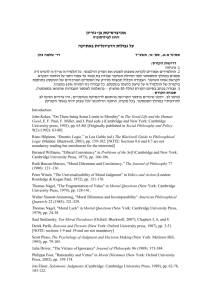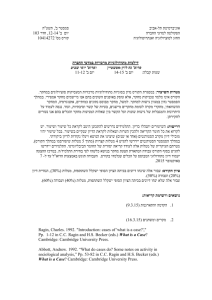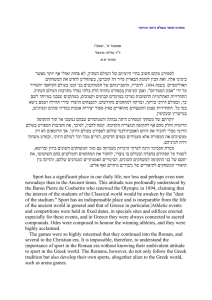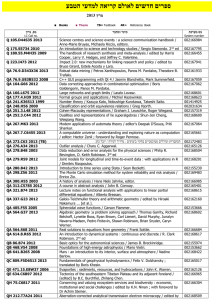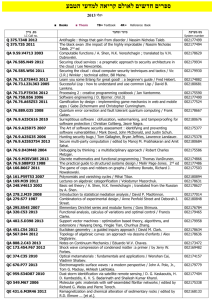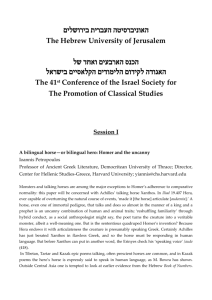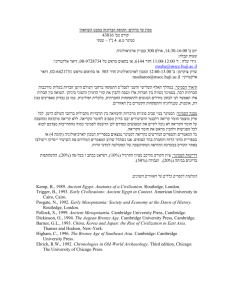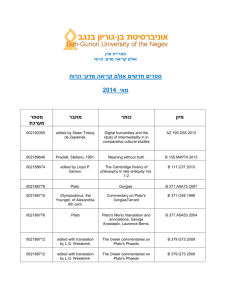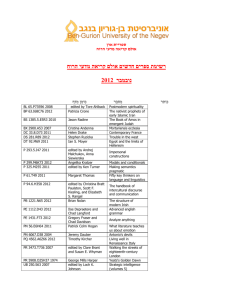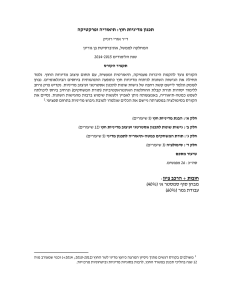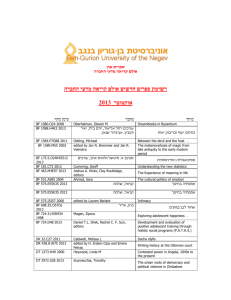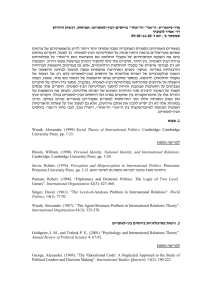טופס סילבוס - אוניברסיטת תל אביב
advertisement
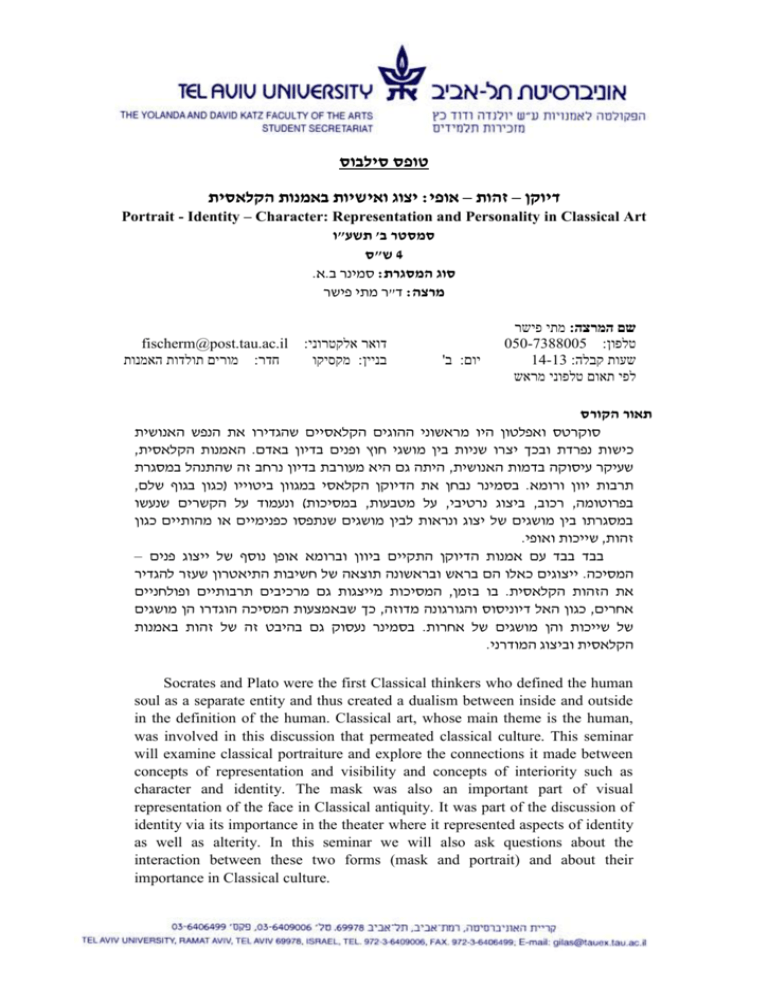
טופס סילבוס דיוקן – זהות – אופי :יצוג ואישיות באמנות הקלאסית Portrait - Identity – Character: Representation and Personality in Classical Art סמסטר ב' תשע"ו 4ש"ס סוג המסגרת :סמינר ב.א. מרצה :ד"ר מתי פישר שם המרצה :מתי פישר טלפון050-7388005 : שעות קבלה14-13 : לפי תאום טלפוני מראש יום :ב' דואר אלקטרוני: בניין :מקסיקו fischerm@post.tau.ac.il חדר :מורים תולדות האמנות תאור הקורס סוקרטס ואפלטון היו מראשוני ההוגים הקלאסיים שהגדירו את הנפש האנושית כישות נפרדת ובכך יצרו שניות בין מושגי חוץ ופנים בדיון באדם .האמנות הקלאסית, שעיקר עיסוקה בדמות האנושית ,היתה גם היא מעורבת בדיון נרחב זה שהתנהל במסגרת תרבות יוון ורומא .בסמינר נבחן את הדיוקן הקלאסי במגוון ביטוייו (כגון בגוף שלם, בפרוטומה ,רכוב ,ביצוג נרטיבי ,על מטבעות ,במסיכות) ונעמוד על הקשרים שנעשו במסגרתו בין מושגים של יצוג ונראות לבין מושגים שנתפסו כפנימיים או מהותיים כגון זהות ,שייכות ואופי. בבד בבד עם אמנות הדיוקן התקיים ביוון וברומא אופן נוסף של ייצוג פנים – המסיכה .ייצוגים כאלו הם בראש ובראשונה תוצאה של חשיבות התיאטרון שעזר להגדיר את הזהות הקלאסית .בו בזמן ,המסיכות מייצגות גם מרכיבים תרבותיים ופולחניים אחרים ,כגון האל דיוניסוס והגורגונה מדוזה ,כך שבאמצעות המסיכה הוגדרו הן מושגים של שייכות והן מושגים של אחרות .בסמינר נעסוק גם בהיבט זה של זהות באמנות הקלאסית וביצוג המודרני. Socrates and Plato were the first Classical thinkers who defined the human soul as a separate entity and thus created a dualism between inside and outside in the definition of the human. Classical art, whose main theme is the human, was involved in this discussion that permeated classical culture. This seminar will examine classical portraiture and explore the connections it made between concepts of representation and visibility and concepts of interiority such as character and identity. The mask was also an important part of visual representation of the face in Classical antiquity. It was part of the discussion of identity via its importance in the theater where it represented aspects of identity as well as alterity. In this seminar we will also ask questions about the interaction between these two forms (mask and portrait) and about their importance in Classical culture. דרישות הקורס כתיבת עבודה, רפרט, קריאה, השתתפות,נוכחות חובה מרכיבי הציון הסופי עבודה100% פירוט נושאי הקורס וביבליוגרפיה !שימו לב! הקריאה המדויקת לכל שיעור תינתן לפני השעור באמצעות אתר מודל דיוקן וזהות: מבוא:1 שעור Woodall, Joanna. Portraiture, Facing the Subject. Manchester: Manchester University Press, 1997, 1-28 (“Introduction – facing the Subject”). West, Shearer. Portraiture. Oxford: Oxford University Press, 2004, 71-103 (“Power and Status”) Steiner, Wendy. "The Semiotics of A Genre, Portraiture in Literature and Painting". Semiotica. 21 (1977): 110-119. Gombrich, Ernst. "The Mask and the Face, The perception of physiognomic likness in life and art" in Art Perception and Reality, E. Gombrich et al. eds. Baltimore : Johns Hopkins, 1972: 1-46. Pollitt, Jerome. The Art of Ancient Greece, Sources and Documents. Cambridge: Cambridge University Press, 1986: 27-30. Baker, George. "Photography between Narrativity and Stasis: August Sander, Degeneration, and the Decay of the Portrait". October. Vol. 76 (Spring, 1996), pp. 72-113 אלימות ומוות בעולם העתיק, זהות, דיוקן: הדיוקן ככפיל:2 שעור Breckenridge, James. Likeness, A Conceptual History of Ancient Portraiture. Evanston: Northwestern University Press, 1968, 15-80. (“The Prehistory of the Portrait”). Bahrani Zainab. “Assault and Abduction: The Fate of the Royal Image in the Ancient Near East.” Art History. 18 n.3 (1995), 363-382. Filer J. M. “If the Face Fits… A Comparison of Mummies and their Accompanying Portraits Using Computerised Axial Tomography”. in M. L. Bierbrier ed. Portraits and Masks, Burial Customs in Roman Egypt. London 1997, 121-126. Frieslaender Elisheva. “Death and Transfiguration: Funerary Characteristics of the Fayum Portraits”, in Asher Ovadiah ed. Milestones in the Art and Culture of Egypt, Tel-Aviv: Tel Aviv University, 2000, 89-99. Montserrat D. “Death and Funerals in the Roman Fayum”. in M. L. Bierbrier ed., Portraits and Masks, Burial Customs in Roman Egypt, London 1997, 33-44. Jones, Amelia. "The “Eternal Return”: Self‐Portrait Photography as a Technology of Embodiment" Signs. Vol. 27, No. 4 (Summer 2002), pp. 947-978. . הדיוקן היווני והפוליטיקה היוונית: זהות אישית ושייכות פוליטית:3 שעור Said, Suzanne. “Tragey and Politics.” In Democracy Empire and the Arts in Fifth Centry Athens, edited by D. Boedeker and K. Raaflaub. Cambridge Mass. Harvard University press. 1998, 275-295. (Tragedy as model for political thinking and for relations between leader and community) Holscher, Tonio. “Images and Political Identity.” In Democracy Empire and the Arts in Fifth Centry Athens, edited by D. Boedeker and K. Raaflaub. Cambridge Mass. Harvard University press. 1998, 153-183. Breckenridge, James. Likeness A Conceptual History of Ancient Portraiture. Evanston: Northewestern University press, 1968, 81-142 (“The Portrait in Greek Art”). . תפקידי המסיכה בפולחן ובתאטרון הקלאסי: זהות ואחרות:4 שעור הוצאת ספרים: ירושלים. תיאטרון ודרמה ביון וברומא: גם סוקרטס בעננים.גילולה דבורה .40-9 :1996 , האוניברסיטה העברית,ע"ש י"ל מאגנס Simon, Erika. The Ancient Theater. translated by C.E. Vafopoulou-Richardson. London and New York: Methuen, 1972: 3-33 (“Ancient Greek Theater”) Marshall, C.W. "Some Fifth Century Masking Conventions", Greece and Rome, 46 (1999), 188-202. Cole, Susan G. "Procession and Celebration at the Dionysia." in Theater and Society in the Classical World. edited by Ruth Scodel, 25-38. Ann Arbor: University of Michigan Press, 1993. Easterling, Patricia E. "Tragedy and Ritual." in Theater and Society in the Classical World, edited by Ruth Scodel, 7-24. Ann Arbor: University of Michigan Press, 1993. Frontisi-Ducroux, Francoise. "In the Mirror of the Mask". in C. Berard ed. A City of Images, Princeton 1989, 151-164. Burkert, Walter., "Greek Tragedy and Sacrificial Ritual". Greek, Roman and Byzantine Studies, 7 (1966): 87-121. Halliwel, Francis S., "The Function and Aesthetics of the Greek Tragic Mask", Drama, 2, 195-211 = N. W. Slater and B. Zimmerman eds. Intertextualität in der griechishe-römischen Komödie. Stuttgart 1993, 195-211. . המסיכה הסטירית: דיוקן וקריקטורה:5 שעור Baron, James R. "Tricksters and Typists, 9-5 as an Aristophanic Comedy". in Classical Myth and Culture in the Cinema. Edited by Martin M. Winkler, 172192. Oxford: Oxford University Press, 2001. Green, Richard and Eric W. Handley. Images of the Greek Theatre. London: British Museum Press, 1995: 22-29, 49-57 (ch.2 “The Satyr Play”, ch.4. “Aristophanes and Others, the Comedy of Classical Athens”) Robertson, Martin. A History of Greek Art. London : Cambridge University Press, 1975: 417, 429, 491 (Caricature) Wiles, David. "The Poetics of the Mask in Old Comedy" in Martin Revermann and Peter Wilson eds. Performance, Iconography, Reception : Studies in Honour of Oliver Taplin. Oxford and New York: Oxford University Press, 2008: 374392. Athanassoglou-Kallmyer, A. "Ugliness." in Critical Terms for Art History. Edited by Robert S. Nelson and Richard Shiff, 281-295. Chicago and London: University of Chicago Press, 2003. Trendall A. D. "Farce and tragedy in South Italian Vase paintings." in Looking at Greek Vases. Edited by T. Rasmunssen, 151-182.Cambridge: Cambridge University Press, 1991. . דיוקנאות המלכים ההלניסטיים: מנהיגות וכוח, דיוקן:6 שעור Smith, R.R.R. Hellenistic Royal Portraits. Oxford: Clarendon Press, 1988, 46-53 (“Royal Image and Kingship Theory”) Walbank W. F. "Monarchy and Monarchic Ideas” Cambridge Ancient History (second edition 1984) 7.1, 62-100. Macurdy, Grace. Hellenistic Queens: A Study of Woman Power in Macedonia, Seleucid, Syria, and Ptolemaic Egypt. New York: AMS Press, 1977. Pollitt, Jerome J. Art in the Hellenistic Age. Cambridge: Cambridge University Press, 1986, 59-78 ("Personality and Psychology in Portraiture"). אישיות ואופי בפיזיוגנומיה העתיקה ובהשקפות, מסיכה, דיוקן:" ל"קרוא את הפנים:7 שעור .מודרניות Stewart, Andrew. Faces of Power. Berkely: University of California Press, 1993, 71102, 143-144, 158-171. (“Alexander, an Encouter”, Alexander’s sexuality and physiognomics). Killerich Bente. "Physiognomics and the Iconography of Alexander", Symbolae Osloenses, 63 (1988), 51-66. Hanfmann G. "Personality and Portraiture in Ancient Art", Proceedings of the American Philosophical Society, 117 (1973), 259-270. Wiles, David. The Masks of Menander. Cambridge: Cambridge University Press, 1991: chapter 3, 6, 7, (esp. pp. 3-4, 24-25, 71-74, 173-174, 190, 202-3). Bernabo Brea, Luigi. "Masks and Characters of the Greek Theatre in the Terracottas of Ancient Lipara." Mediterranean Archaeology 5/6 (1992/1993): 23-31. Berry, Diane,. and Julia L. Finch Wero. "Accuracy in Face Perception: A View from Ecological Psychology." Journal of Personality 61 n. 4 (1993): 497-520. Sobieszek, Robert A. Ghost in the Shell Photography and the Human Soul, 18502000. Cambridge, Mass.: MIT Press and the Los Angeles County Museum of Art, 1999. Welchman, John C. Review of: Ghost in the Shell: Photography and the Human Soul, 1850-2000 by Robert A. Sobieszek. The Art Bulletin. Vol. 83, No. 1 (Mar., 2001), pp. 161-165 דיוקנאות אינטלקטואלים ודיוקנאות נשים בתקופה: דיוקן ושייכות או לכלול את כולם:8 שעור ההלניסטית Zanker, Paul. The Mask of Socrates. Berkeley: University of California Press, 1995, 40-197. Smith R.R. "Kings and Philosophers" in Images and Ideologies, Self definition in the Hellenistic World, edited by A. Bulloch. Berkeley : University of California Press, 1993, 202-211 Caizzi, F. "The Porch and The Garden, Early Hellenistic Images of the Philosophical life" in in Images and Ideologies, Self definition in the Hellenistic World, edited by A. Bulloch. Berkeley: University of California Press, 1993, 303-329 Henry, Madeleine, "Ethos Mythos Praxis: Women in Menander's Comedy". Helios 13 (1986): 141-150. . הדיוקנאות הרומיים ומסיכות האבות: דיוקן ומסורת:9 שעור .1988 , דביר: אביב- תל. נצחונה של מתינות, אוגוסטוס. צבי,יעבץ Galinsky, Karl. Augustan Culture. Princeton: Princeton University Press, 1996. 141224 (“Art and Architecture”) Arendt, Hanna. “What is Authority.” In Six Excercises in Political Thought. London: Faber, 1961, 91-141. Nodelman, Sheldon. "How to Read a roman Portrait". Art in America, 63 (1975): 2733. Hanfmann, G. "Observations on Roman Portraiture I-VI", Latomus, 11 (1952) 204215, 454-466. Segal, Erich. Roman Laughter : the Comedy of Plautus. New York: Oxford University Press, 1987: 1-69. Flower, Harriet. Ancestor Masks and Aristocratic Power in Roman Culture. Oxford: Clarendon Press, 1996: 1-59. . הפרסונות של קיסרי רומא: ריבוי פנים:10 שעור Gill, Christopher. “Personhood and Personality: The Four Personae Theory in Cicero De Officiis I”, Oxford Studies in Ancient Philosophy, 6 (1988): 169-199. Price, S. R. "Gods and Emperors: The Greek Language of Roman Imperial Cult" Journal of Hellenic Studies, 104 (1984): 75-95. Walbank, F. W. "Nationality as a factor in Roman History." Harvard Studies in Classical Philology 76 (1972): 145-168. Varner. Eric R. Mutilation and Transformation: Damnatio Memoriae and Roman Imperial Portraiture. Leiden, Brill 2004. 1-20, 105-125. Lewis, Ewart. “Review of The King’s Two Bodies” by Ernst Kantorowicz, Political Science Quarterly 73 n.3 (1958): 453-455 Rogin, Michael P. Ronald Reagan The Movie and other episodes in political demonology. Berkeley: University of California Press, 1987, 1-43, 81-114 (“Ronald Reagan the Movie” and “The King’s two Bodies”). Pliny the younger, Panegyrycus, in Letters and Panegyricus, (trans. B. Radice, Loeb Classical Library, London and Cambridge Mass. 1976). Barton, Carlin. A. The Sorrows of the Ancient Romans, The Gladiator and The Monster, Princeton: Princeton University Press, 1993, 12-36. Dio Chrysotomus “Third Discourse on Kingship” in Discourses, trans. W. C. Cohoon, London and Cambridge Mass.: Loeb Classical Library, 1949. Aelius Aristides, "Regarding Rome" in The Complete Works, Vol. 2, trans. C. A. Behr, Leiden 1981. Bergmann B. "The Roman House as a Memory Theater: The House of the Tragic Poet in Pompeii." Art Bulletin 76 (1994): 225-255. . רפרטים:13-11 שעור . מצגות השעורים יופיעו באתר הקורס:חומר עזר נוסף . על התלמידים יהיה לתת רפרטים בנושאים שייקבעו:הערות או שונות רשימת ספרות נוספת Aristotle, Nichomachian Ethics. Translated by H. Rackham. London and Cambridge Mass.: Loeb Classical Library, 1956. Athanassoglou-Kallmyer, A. "Ugliness." in Critical Terms for Art History. Edited by Robert S. Nelson and Richard Shiff, 281-295. Chicago and London: University of Chicago Press, 2003. Bahrani Zainab. “Assault and Abduction: The Fate of the Royal Image in the Ancient Near East.” Art History. 18 n.3 (1995), 363-382. Bakhtin M. M. The Dialogic Imagination : four essays. edited by Michael Holquist ; translated by Caryl Emerson and Michael Holquist. Austin: University of Texas Press, 1981: ch.3 (“Forms of Time and of the Chronotope in the Novel”- Greek novel) Bartlett, F.C. "The Social Psychology of Leadership", Journal of the National Institute of Industrial Psychology 3(1926): 188-193. Bartsch Shadi. Actors in the Audience, Theatricality and Doublespeak from Nero to Hadrian. Cambridge and London: Harvard University Press, 1994. Bernabo Brea, Luigi. Maschere e personaggi del teatro greco nelle terracotte liparesi. Roma: "L'Erma" di Bretschneider, 2001. Berry, Diane,. and Julia L. Finch Wero. "Accuracy in Face Perception: A View from Ecological Psychology." Journal of Personality 61 n. 4 (1993): 497-520. Brilliant Richard. Gesture and Rank in Roman Art. New Haven, Conn.: Published by the Academy, 1963. Bringmann, K. "The King as Benefactor" in Images and Ideologies, Self definition in the Hellenistic World, edited by A. Bulloch. Berkeley: University of California Press, 1993, 7-24. Burian P., "Myth into Mythos: The Shaping of the Tragic Plot." in The Cambridge Companion to Greek Tragedy, edited by P. E. Easterling, 178-208. Cambridge: Cambridge University Press, 1997. Cheater, Angela. “Power in the Postmodern era” in The Anthropology of Power, edited by Angela Cheater. New York: Routledge, 1999, 1-13. Csapo Eric. "A Case Study in the use of Theatre Iconography as Evidence for Ancient Acting" Antike Kunst 36 (1993): 41-56. Csapo, E., "Performance and Iconographic Tradition in the Illustrations of Menander." Syllecta Classica 10 (1997): 154-188. Davis, Jessica Milner. Farce. London: Methuen, 1978. De Vos, George A. and Lola Romanucci-Ross, "Ethnic Identity – A Psychocultural Perspective" in Ethnic identity, Creation Conflict and Accomodation edited by G. A. De Vos and L. Romnucci-Ross, Walnut Creek and London: Sage, 1995, 349379. Fischer, Matti. "Portrait and Mask, Signifiers of the Face in Classical Antiquity." Assaf, Studies in Art History. 6 (2001): 31-62 Fischer, Matti. "Patriae faciem: the Emperor's Portrait as a Signifier of Roman Identity in the First and Second Centuries C.E." in Kallathos, Studies in Honour of Asher Ovadiah, edited by S. Mucnick, Tel-Aviv: Tel-Aviv University Press, 2006, 529-568. Flower Hariet. Ancestor Masks and Aristocratic Power in Roman Culture, Oxford: Oxford University Press, 1996. Foucault, Michel. “The Subject and Power.” Critical Inquiry 8 (summer 1982): 777795. Frontisi-Ducroux, F., "In the Mirror of the Mask" in A City of Images. Edited by J. P. Vernant et. al., 151-164. Princeton: Princeton University Press, 1989. Gardner, Jane. Leadership and the Cult of Personality (The Ancient World Source books), London: Dent, 1974. 28-52 Geertz, C. “From the Native’s Point of View, On the Nature of Anthropological Understanding.” in Culture Theory, Essays on Mind Self and Emotion, edited by R.A. Shweder and R.A. LeVine 123-136. Cambridge: Cambridge University Press, 1984. Gillespie. P. and M. Cameron. "Ritual Theories of the Origin of Drama" in Western Theatre – Revolution and Revival, Edited by Patti P. Gillespie, Kenneth M. Cameron, 43-48. New York: Macmillan, 1984. Goldhill Simon ed. Performance Culture and Athenian Democracy. Cambridge: Cambridge University Press, 1999: 10-26. Goldhill, Simon.D. "The Great Dionysia and Civic Ideology.” The Journal of Hellenic Studies 107 (1987): 58-76. Green, J. R. "Theatrical Motifs in Non Theatrical contexts on Vases of the later Fifth and Fourth Centuries". in Stage Directions: Essays in Ancient Drama in Honour of E. W. Handley. Edited by A Griffiths, 93-122, London : Institute of Classical Studies, 1995. Green, J. R. “A Representation of the Birds of Aristophanes.” In Greek Vases in the J. Paul Getty Museum 2 (1985): 95-118. Green, J.R. "On Seeing and Depicting the Theatre in Classical Athens," Greek Roman and Byzantine Studies 32 (1991): 15-50. Gruen, Erich. Culture and National Identity in Republican Rome, London: Duckworth, 1993. Holliday, Vivian L. “Rhetoric, Iconography, and Leadership in Classical Antiquity: Pericles and Augustus.” In Classical and Modern Narratives of Leadership, edited by Vivian L Holliday. Wauconda Illinois: Bolchazy Carducci Pub, 2000, 11-44. Jenkins, Marianna.The State Portrait, Its Origin and Evolution, New York: College Art Association, 1947, 1-47. (Sorasky Library Etext: http://quod.lib.umich.edu/cgi/t/text/text-idx?c=acls;idno=heb04009 Kilerich, Bente. "Physiognomics and the Iconography of Alexander." Symbolae Osloenses 63, (1988): 51-66. Koenen L. "The Ptolemaic King as a Religious figure" in Images and Ideologies, Self definition in the Hellenistic World, edited by A. Bulloch. Berkeley: University of California Press, 1993, 25-115. Leach Edmund. Culture and Communication. Cambridge: Cambridge University Press 1976: 77-93 ("Rites of Transition" and "The Logic Of Sacrifice"). Macurdy, Grace. Hellenistic Queens: A Study of Woman Power in Macedonia, Seleucid, Syria, and Ptolemaic Egypt. New York: AMS Press, 1977. Malamud M. "Brooklyn on the Tiber: Roman Comedy on Broadway and in Film". in Imperial Projections: Ancient Rome in Modern Popular Culture, edited by Sandra Joshel, Margaret Malamud, Donald T. McGuire, 191-208. Baltimore: Johns Hopkins University Press, 2001. Neiiedam, Klaus. The Art of Acting in Antiquity. Copenhagen: Museum Tusculanum Press, 1991: 15-62 (“the Phlyax Farce”), 63-93 (Comedy and Tragedy: Hellenistic Theater Pictures in Later Mosaics and Frescoes”). Pitsis, Tyrone S. "Leadership." Blackwell Encyclopedia of Sociology. Ritzer, George (ed). Blackwell Publishing, 2007. Blackwell Reference Online. Pollitt, J.J. Art in the Hellenistic Age. Cambridge: Cambridge University Press, 1988, 19-46 (“Royal Iconography”). Price, S. R. Rituals and Power, The Roman Imperial Cult in Asia Minor, Cambridge: 1984. Revermann Martin and Peter Wilson eds. Performance, iconography, reception : studies in honour of Oliver Taplin. New York: Oxford University Press, 2008. (ch. 17. Robin Osborne “Putting Performance into Focus”). Revermann Martin and Peter Wilson eds. Performance, Iconography, Reception : Studies in Honour of Oliver Taplin. Oxford and New York: Oxford University Press, 2008: (ch 16. David Wiles. “The Poetics of the Mask in Old Comedy.”) Revermann Martin and Peter Wilson eds. Performance, Iiconography, Reception : Studies in Honour of Oliver Taplin. Oxford and New York: Oxford University Press, 2008. (ch. 2. Ian Ruffell, “Audience and Emotion in the Reception of Greek Drama”) Rubinfeld M. Bound to Bond, Gender, Genre and the Hollywood Romantic Comedy. Westport, Conn.: Praeger, 2001. Schiffer, Irvin. Charisma: a Psychoanalytic Look at Mass Society. Toronto: University of Toronto press, 1973, 4-55. Schomburg-Scherff, Sylvia. “The Power of Images – New Approaches to the Anthropological Study of Images.” Anthropos. 95 (2000): 189-199. Scolnicov Hanna. Woman's Theatrical Space. Cambridge: Cambridge University Press, 1994: 1-68. Seeberg A. "From Padded Dancers to Comedy" in Stage Directions, Essays in Ancient Drama in Honour of E. W. Handley. Edited by A. Griffiths, 1-12. London: Institute of Classical Studies, 1995. Slater Niall W. Spectator Politics : Metatheatre and Performance in Aristophanes. Philadelphia, Pa.: University of Pennsylvania Press, 2002. Slater, Niall W. Plautus in Performance : the Theatre of the Mind. Amsterdam: Harwood Academic, 2000. Smith, R.R.R. Hellenistic Royal Portraits. Oxford: Clarendon Press, 1988, 46-53 (“Royal Image and Kingship Theory”) Sourvinou-Inwood, C. "Something to do with Athens: Tragedy and Ritual." in Ritual, Finance, Politics: Athenian Democratic Accounts Presented to David Lewis, edited by R. Osborne and S. Hornblower, 269-290. Oxford: Clarendon Press, 1994. Stevenson, P. R. "The Ideal Benefactor and The Father Analogy in Greek and Roman Thought" Classical Quarterly, 42 (1992): 421-436. Statman D. Virtue Ethics. Edinburgh: Edinburgh University Press, 1997. Stewart, Andrew. Faces of Power. Berkely: University of California Press, 1993, 71102, 143-144, 158-171. (“Alexander, an Encouter”, Alexander’s sexuality and physiognomics). Stone, Laura M. Costume in Aristophanic Poetry. New York: Arno, 1981. Taplin Oliver. Pots & Plays : Interactions Between Tragedy and Greek Vase-Painting of the Fourth Century B.C. Los Angeles: J. Paul Getty Museum, 2007. Taplin, Oliver. Comic Angels and Other Approaches to Greek Drama through VasePainting. Oxford: Clarendon Press, 1993: 30-47 (ch. 4 “Comedy and Iconography”). Trendall A. D. "Farce and tragedy in South Italian Vase paintings." in Looking at Greek Vases. Edited by T. Rasmunssen, 151-182.Cambridge: Cambridge University Press, 1991. Trendall A. D. "Masks on Apulian Red Figured Vases." in Studies in Honour of T. B. L. Webster. Edited by J. H. Betts, J. T. Hooker and J. R. Green, Vol. 2, 137154. Bristol: Bristol Classical Press, 1988. Trendall A. D. "Masks on Apulian Red Figured Vases." in Studies in Honour of T. B. L. Webster. Edited by J. H. Betts, J. T. Hooker and J. R. Green, Vol. 2, 137-154. Bristol: Bristol Classical Press, 1988. Vermeule, C. "Hellenistic and Roman Cuirassed Statues", Berytus 13 (1959-60): 3-82. Vernant J. P. Mortals and Immortals. edited by Froma I. Zeitlin. Princeton, N.J.: Princeton University Press, 1991: (ch. 12 “Artemis and the rites of sacrifice initiation and marriage”) Vernant J. P. Myth and Tragedy in Ancient Greece. New York: Zone Books 1990: 2948 (ch. 2: "Tensions and Ambiguities in Greek Tragedy") Vidal Naquet P. "Hunting and Sacrifice in Aeschylus' Oresteia". in Myth and Tragedy in Ancient Greece. Edited by J. P. Vernant and P. Vidal Naquet, 141-159. New York: Zone Books, 1990. Walbank W. F. "Monarchy and Monarchic Ideas” Cambridge Ancient History (second edition 1984) 7.1, 62-100. Walker, Susan. Greek and Roman Portraits. London: Brotish Museum, 1995, 16-27, 28-40 (“What is a Portrait for?”, “The beginnings of Greek portraiture”) Weber, Max. "The three types of legitimate rule". Translated by Hans Gerth, Berkeley Journal of Sociology (Berkeley Publications in Society and Institutions), 4 (1): 111. 1958. Weber, Max. collection of writings online: http://www.sociosite.net/topics/weber.php Weber, Max. From Max Weber: Essays in Sociology. translated, edited and with an introduction by H.H. Gerth, and C. Wright Mills. London: Routledge 1991 (new edition). Weber, Max. The Sociology of Religion, translated by Ephraim Fischoff ; introd. by Talcott Parsons, London: Methuen, 1965. Webster T.B.L. An Introduction to Menander. New York: Manchester University Press, 1974: 89-99 (Masks and Names). Webster, T. B. L. The Greek Chorus. London: Methuen, 1970: 1-31. Wiedeman, Thomas. Emperors and Gladiators. London: Routledge, 1995, 165-180 (“Conclusion: Imperial Sovereignity and Popular Sovereignity”). Wiles David. Greek Theatre Performance. Cambridge: Cambridge University Press, 2000: 122-127. Wiles David., Greek Theater Performance. Cambridge: Cambridge University Press. 2000: ch. 4 "Politics" and pp.19-20, 58-59, 148-159. Wiles, David. Tragedy in Athens: Performance Space and Theatrical Meaning. Cambridge: Cambridge University press, 1997: 1-22 (ch. 1 “ The Problem of Space”) Wilkins John. "The State and the Individual, Euripides's plays of self-sacrifice." in Euripides, Women and Sexuality. Edited by A. Powell, 177-194. London: Routledge, 1990. Zagagi Neta. The Comedy of Menander : Convention, Variation, and Originality. Bloomington : Indiana University Press, 1995: 66 -71 ("Emphasis on human interaction") Zanker, Paul. The Mask of Socrates. Berkeley: University of California Press, 1995, 14-39. (“Image Space and Social Values”). Zanker, Paul. The Power of Images in the Age of Augustus. Ann Arbor: University of Michigan Press, 1990. Zeitlin, F.I. "Playing the Other: Theater, Theatricality, and the Feminine in Greek Drama." in Nothing to Do with Dionysus? Edited by J.J. Winkler and F.I. Zeitlin, 63-96. Princeton, Princeton University Press, 1990.
